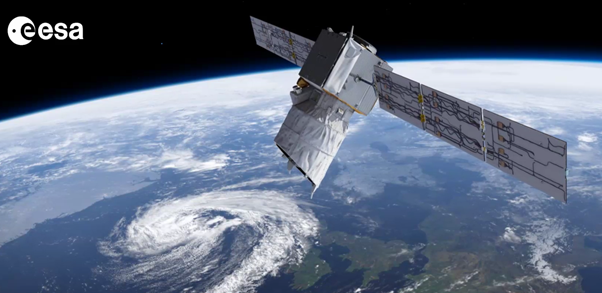Introduction to Aeolus
Aeolus is the fifth satellite in the Living Planet Programme of the European Space Agency. It was launched on 22 August 2018. The mission's objective is to provide profiles of high-quality wind observations from the surface to the lower stratosphere, using a Doppler wind lidar (DWL) instrument (known as ALADIN) in a near-polar sun-synchronous, dawn-dusk orbit (320 km altitude). The wind information is the horizontal line-of-sight (HLOS) component, in the direction perpendicular to the satellite's velocity. The mission is intended to have a minimum lifetime of three years.
ECMWF is contracted by ESA to develop, in collaboration with KNMI, the Aeolus Level 2B/C processing software i.e. the wind retrieval. The L2B wind retrieval algorithms have also been developed in the past in collaboration with Météo-France, DLR and LMD/IPSL. ECMWF will generate the L2B products operationally and in NRT in the L2/Met PF (Level-2/Meteorological Processing Facility; a part of the mission's Ground Segment), and will disseminate the products to ESA for further distribution to users. ECMWF will also convert the L2B Earth Explorer format products to a WMO approved BUFR format and will provide these to EUMETSAT for further distribution to the NWP/research community via the GTS.
ECMWF intend to assimilate the Aeolus L2B wind observations in ECMWF's global NWP (Numerical Weather Prediction) model if they are able to improve forecast skill. ECMWF has contributed to ESA funded observation impact studies to assess the potential impact of the Aeolus data. We expect the Aeolus mission to have a positive impact on analysis and forecast quality, particularly tropical winds.
Given that ALADIN is a High Spectral Resolution Lidar, it is also possible to derive information useful for atmospheric composition modelling. Aeolus will also provide information on the atmosphere's cloud and aerosol optical properties (backscatter and extinction coefficients, via the Level-2A product).
Further information:
- See ESA's website on Aeolus
- An introductory presentation about Aeolus L2B winds: Aeolus_L2B_winds.pptx
- Aeolus was launched on 22 August 2018; this website provided a log of progress on the satellite up until launch: https://aeolusweb.wordpress.com/
- A CAL/VAL rehearsal workshop took place in March 2017, the presentations can be found via this web page: http://www.aeolus-calval-2017.org/
- CAL/VAL rehearsal L2B and L2C datasets are available here
- Technical Notes prepared for ESA regarding the L2B/C processing are available here (which might be useful to help understand the L2B products)
- A science blog from ECMWF about our involvement in Aeolus
The L2B processing software
ECMWF and KNMI develop the Aeolus Level-2B wind retrieval software, the main output of which are HLOS wind observations, which are suitable for use in NWP and meteorological research. Read the Algorithm Theoretical Basis document for information about the algorithms (see documentation links below).
Downloading the L2B processing software and documentation
- The Aeolus Level-2B/C processing documentation v3.20 (including the Software Release Note, the Algorithm Theoretical Basis and the Input/Output Data Definitions Interface Control documents) and associated datasets (needed to test the success of the installation) is available for download:
Button Hyperlink title Download Aeolus L2B/C documentation and datasets type standard url L2B processor documentation and datasets - The source code can be freely downloaded from from our website (upon acceptance of the licence terms):
Button Hyperlink title Download Aeolus L2B processor package type standard url http://www.ecmwf.int/en/forecasts/software-and-tools/software/aeolus - News on updates to the software, e.g. planned deliveries, is provided here
- Aeolus L2B winds have a WMO approved BUFR template:
- Some guidance for NWP users on the L2B BUFR data
An example of real Aeolus L2B HLOS winds, from an orbit just to the west of hurricane Dorian on 1/9/2019:



